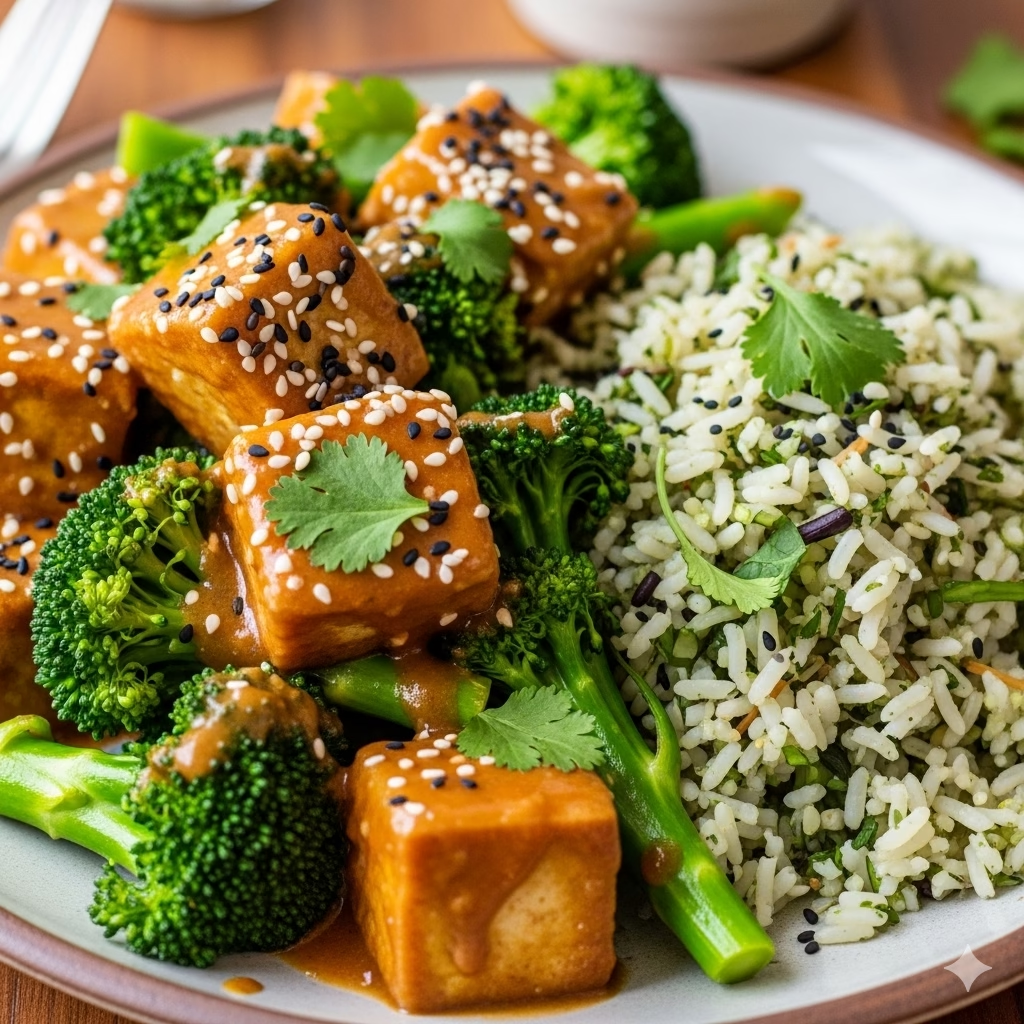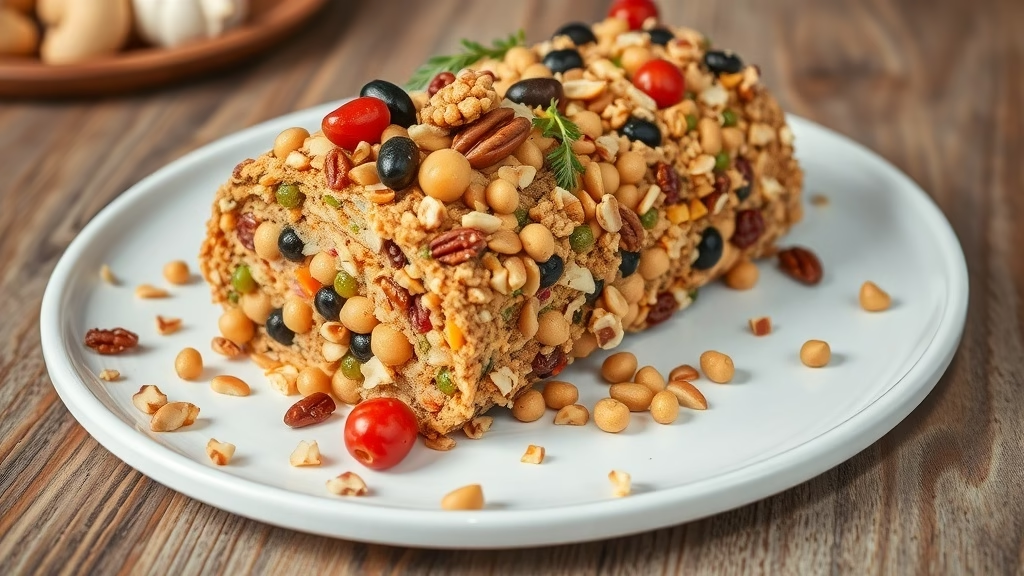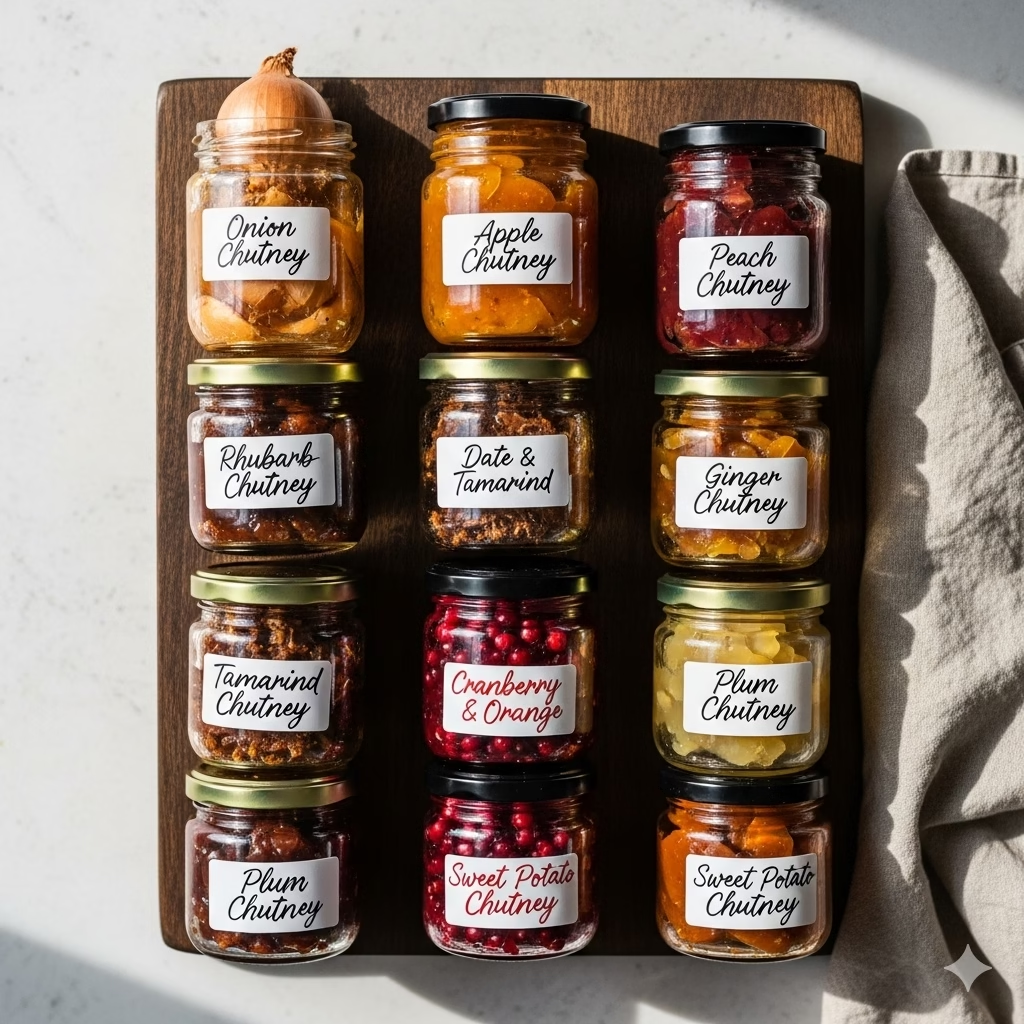
Discover the vibrant world of homemade chutney recipes with this comprehensive guide. Learn to create delicious, healthy condiments that will elevate any meal. Unlock the secrets to preserving flavors and adding a gourmet touch to your cooking.
The Chutney Recipes: A Culinary Adventure
Chutney, a word derived from the Hindi chatni, refers to a family of condiments typically made from fruits, vegetables, and spices. These versatile accompaniments have a rich history, originating in India centuries ago as a means of preserving food and enhancing flavors. From sweet and tangy to spicy and savory, chutneys offer an incredible spectrum of tastes that can transform even the simplest dish into a culinary masterpiece. They are not merely an addition; they are an experience, adding depth, complexity, and often a delightful kick to your palate.
The beauty of homemade chutney recipes lies in its freshness, the control you have over ingredients, and the sheer joy of creating something truly unique in your kitchen. Unlike their store-bought counterparts, homemade chutneys allow you to tailor the sweetness, spiciness, and texture to your exact preferences, ensuring every spoonful is a personalized delight. For the health-conscious individual, this means selecting organic produce, reducing sugar content, and avoiding artificial preservatives, making your chutney both delicious and nourishing.
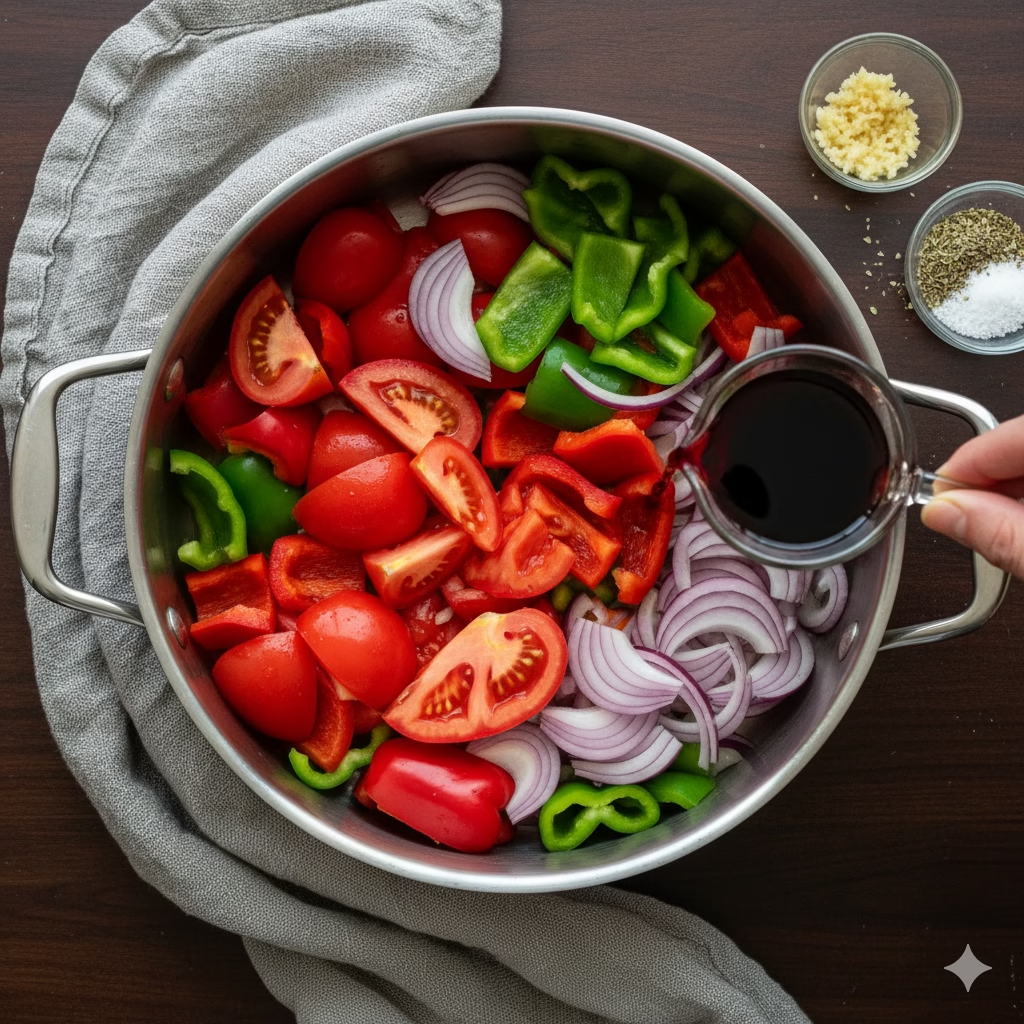
Beyond the Basics: The Versatility of Chutney Recipes
Beyond their incredible flavor, chutney reecipes are also celebrated for their ability to complement a vast array of dishes. Imagine a dollop of tangy mango chutney alongside a rich curry, a spoonful of spicy tomato chutney with grilled cheese, or a vibrant mint chutney brightening up a simple snack. They are perfect partners for cheeses, roasts, sandwiches, and even breakfast items, proving their versatility across all meal occasions. Embracing the art of chutney making opens up a world of culinary possibilities, inviting you to experiment and innovate with flavors.
This comprehensive guide will take you on an exciting journey through 23 diverse chutney recipes, designed to cater to every taste and skill level. Whether you’re a seasoned chef or a kitchen novice, you’ll find clear, easy-to-follow instructions that empower you to create these delicious condiments with confidence. We’ve carefully curated a selection that highlights different flavor profiles, from traditional Indian varieties to modern fusion creations, ensuring there’s a chutney for every occasion and every craving.
So, roll up your sleeves, gather your ingredients, and prepare to embark on a flavorful adventure. By the end of this article, you’ll not only have a collection of incredible chutney recipes at your fingertips but also a deeper appreciation for this ancient and beloved condiment. Get ready to impress your friends and family with your newfound chutney-making prowess!
Crafting Your Own Chutney Recipes: Essential Preparations
Time to Prepare:
- Varies per recipe: Generally 15-30 minutes for chopping and ingredient preparation.
Time to Cook/Blend:
- Varies per recipe: From 5 minutes for blended chutneys to 45-60 minutes for cooked varieties.
Nutritional Information (per typical 2-tablespoon serving, varies by recipe):
- Calories: 30-70 kcal
- Total Fat: 0-2g
- Sodium: 50-150mg
- Total Carbohydrates: 8-15g
- Dietary Fiber: 1-3g
- Total Sugars: 5-12g
- Protein: 0-1g
- Vitamin C: 5-20% Daily Value
- Iron: 2-5% Daily Value
Equipment You’ll Need for Chutney Recipes

- Large saucepan or Dutch oven
- Cutting board
- Sharp knife
- Measuring cups and spoons
- Food processor or blender (for blended chutneys)
- Sterilized jars for storage
- Wooden spoon or spatula
- Grater (optional, for some ingredients)
- Immersion blender (optional)
Servings:
- Each recipe typically yields 4-6 servings, but can be scaled up for larger batches.
Dive into Deliciousness: 23 Chutney Recipes
Here’s your comprehensive guide to making 23 incredible and healthy chutney recipes.
1. Cilantro and Mint (Green) Chutney
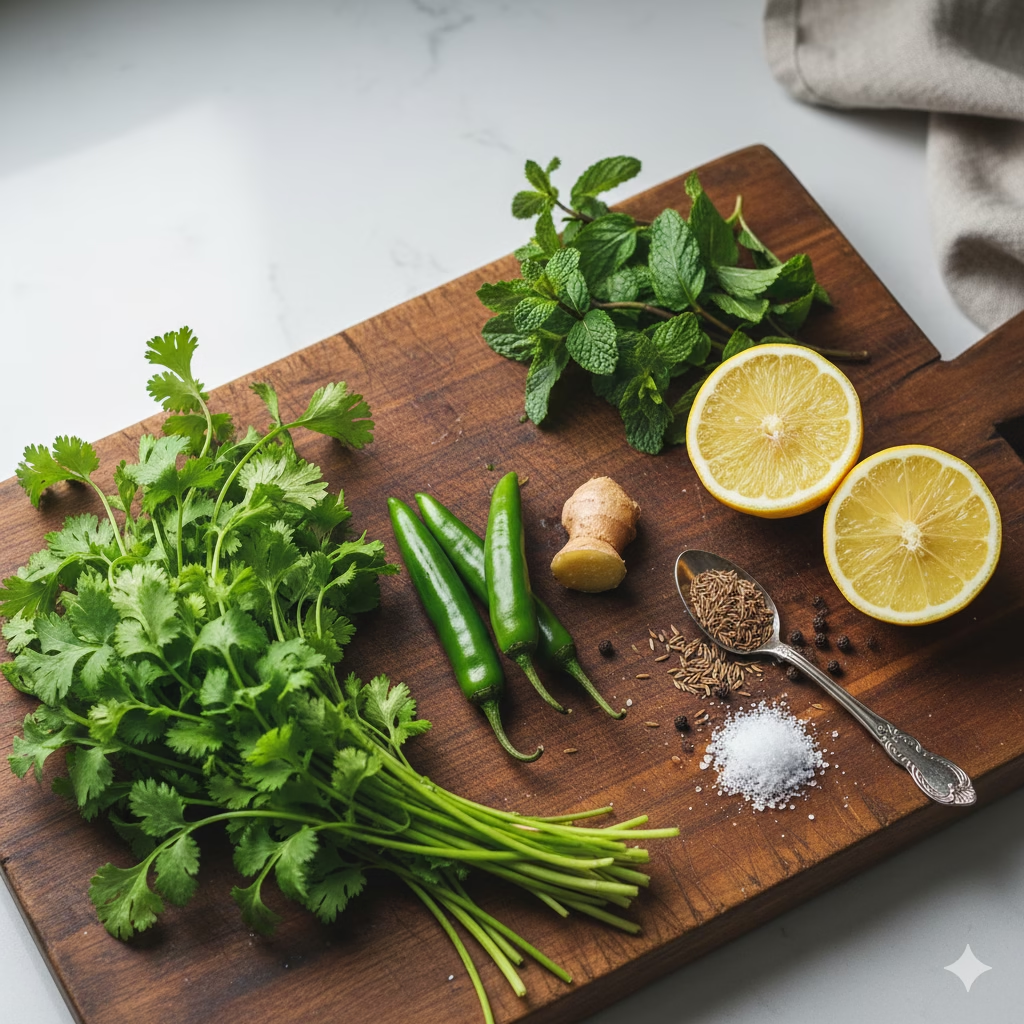
A vibrant, fresh, and essential accompaniment for many Indian snacks.
Ingredients:
- 1 cup fresh cilantro leaves, packed
- ½ cup fresh mint leaves, packed
- 1-2 green chilies (like serrano or jalapeño), stems removed, adjust to taste
- 1-inch piece fresh ginger, peeled
- 2 tablespoons lemon juice (or lime juice)
- ¼ teaspoon black salt (kala namak, optional, for authentic flavor)
- ¼ teaspoon roasted cumin powder
- Salt to taste
- 2-3 tablespoons water (if needed for blending)
Instructions:
Prepare the Herbs: Thoroughly wash the cilantro and mint leaves under cold running water. Shake off excess water and gently pat them dry with a clean kitchen towel or paper towels. This step is crucial to prevent the chutney from becoming watery.
Combine Ingredients: Place the washed cilantro, mint leaves, green chilies (start with one and add more if you prefer spicier), peeled ginger, lemon juice, black salt (if using), roasted cumin powder, and a pinch of regular salt into a blender or food processor.
Blend until Smooth: Begin blending the ingredients. If the mixture is too thick and not blending smoothly, add 1 tablespoon of water at a time, just enough to help the blades move, until you achieve a smooth, vibrant green paste. Be careful not to add too much water, as this can dilute the flavor and consistency.
Taste and Adjust: Taste the chutney and adjust the seasoning as needed. You might want to add more salt, lemon juice for tanginess, or an extra chili for more heat.
Serve or Store: Transfer the fresh green chutney to an airtight container. Serve immediately with samosas, pakoras, chaat, or grilled dishes. It can be stored in the refrigerator for up to 3-5 days.
2. Spicy Red Garlic (Lasan) Chutney
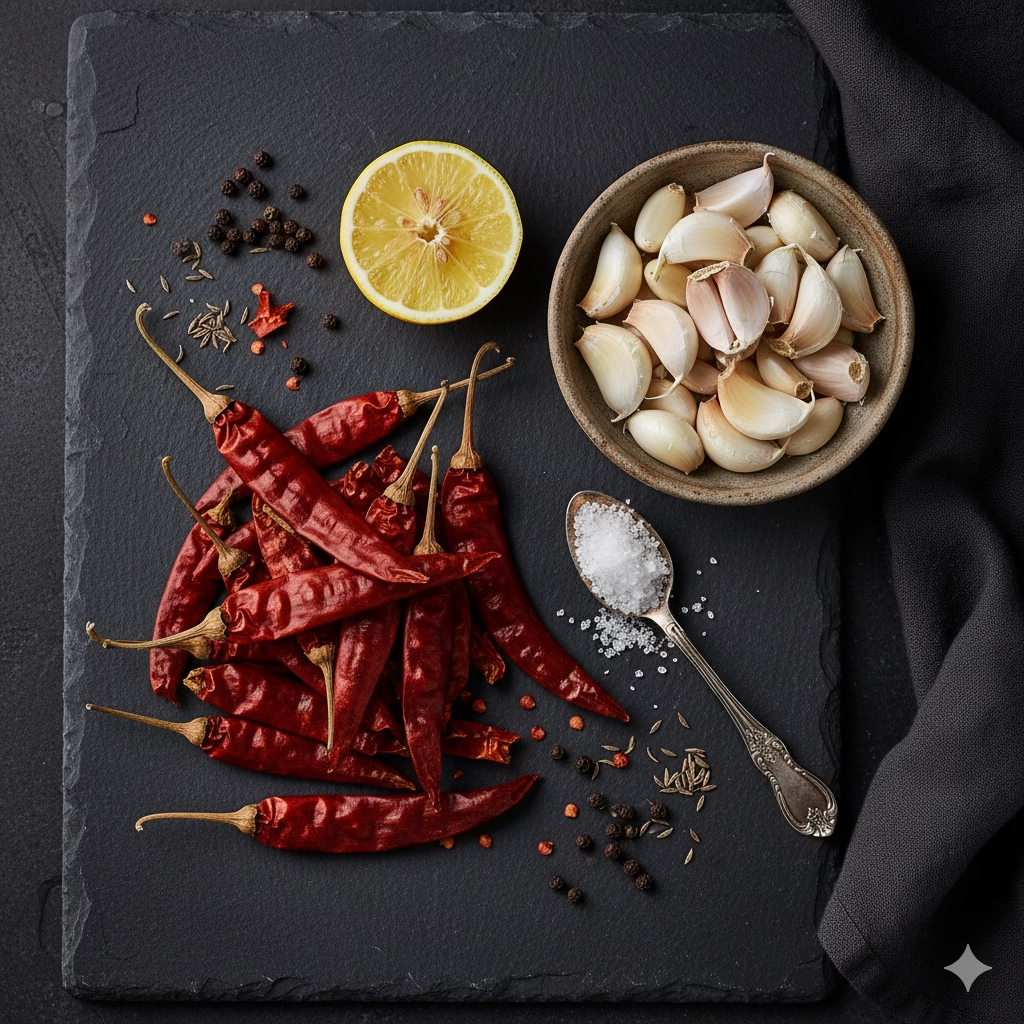
A fiery, pungent, and addictive chutney perfect with flatbreads or as a marinade.
Ingredients:
- 1 whole head garlic, cloves peeled
- 6-8 dried red chilies (like Kashmiri or Byadgi for color, or hotter varieties for more heat), soaked in warm water for 15-20 minutes
- 1 tablespoon lemon juice
- ½ teaspoon cumin seeds (optional)
- Salt to taste
- 1-2 tablespoons water (if needed for blending)
- 1 teaspoon oil (sesame or neutral, optional, for consistency)
Instructions:
- Soak Chilies: Place the dried red chilies in a small bowl and cover them with warm water. Let them soak for 15-20 minutes until they are soft and pliable. This rehydrates them and makes them easier to blend. Drain the water before use.
- Combine Ingredients: In a blender or small food processor, add the peeled garlic cloves, soaked and drained red chilies, lemon juice, cumin seeds (if using), and salt to taste.
- Blend into a Paste: Start blending. The mixture will be thick. Add water gradually, 1 tablespoon at a time, only if absolutely necessary, to help it form a coarse or smooth paste, depending on your preference.
- Add Oil (Optional): If you desire a slightly smoother and richer chutney, you can add 1 teaspoon of oil and blend for another few seconds. This also helps with preservation.
- Taste and Adjust: Check the seasoning and adjust salt or lemon juice. If you prefer it spicier, you can add a pinch of red chili powder.
- Serve or Store: Transfer to an airtight container. This chutney is best fresh but can be stored in the refrigerator for up to a week. It pairs wonderfully with vada pav, dabeli, or spread on toast.
3. Coconut Chutney
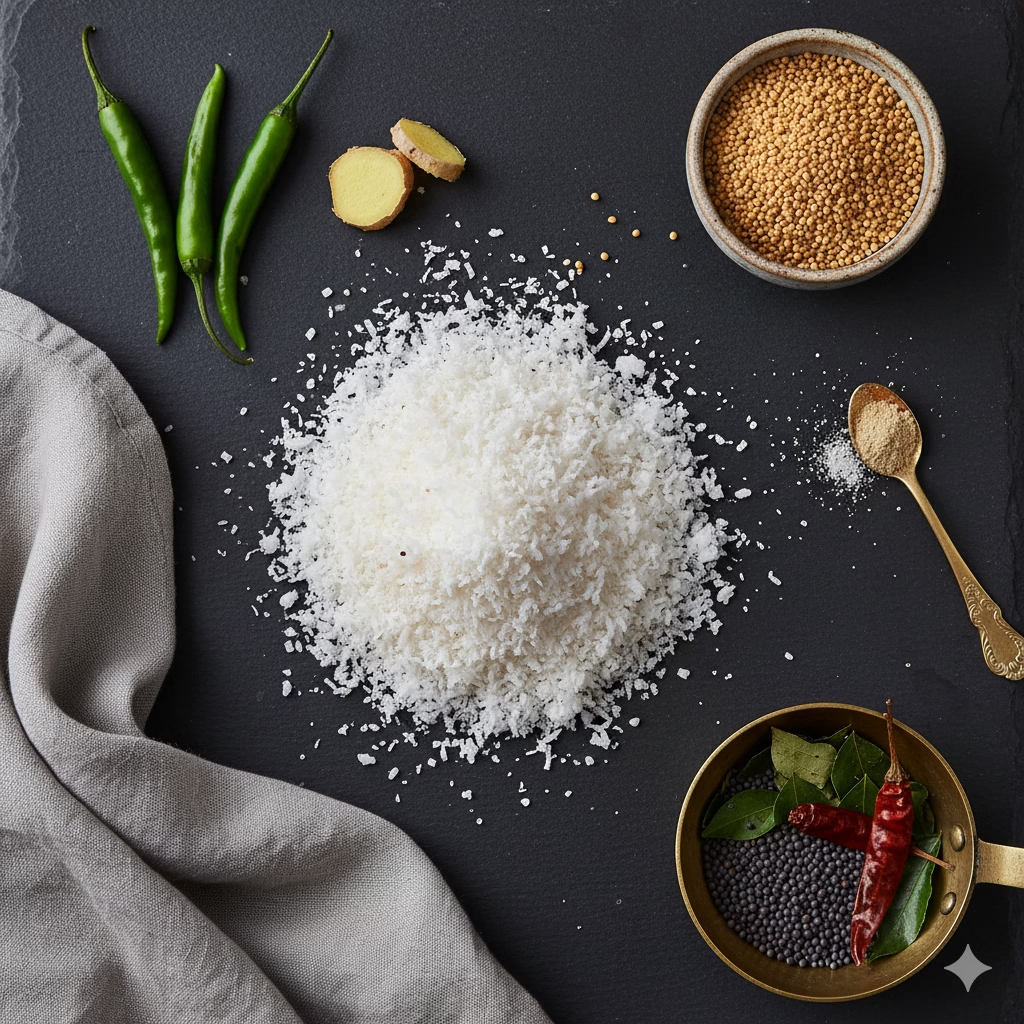
A creamy, mild, and flavorful South Indian staple, perfect with dosas and idlis.
Ingredients:
- 1 cup fresh grated coconut (or unsweetened desiccated coconut, soaked in warm water for 15 minutes)
- 1-2 green chilies, roughly chopped (adjust to spice preference)
- 1-inch piece ginger, peeled and roughly chopped
- 2 tablespoons roasted chana dal (split chickpeas, optional, for thickness)
- 2-3 tablespoons water
- Salt to taste
For Tempering:
- 1 teaspoon coconut oil or vegetable oil
- ½ teaspoon mustard seeds
- Pinch of asafoetida (hing)
- Few curry leaves
- 1-2 dried red chilies, broken
Instructions:
- Prepare Coconut: If using desiccated coconut, soak it in warm water for about 15 minutes, then drain thoroughly. If using fresh coconut, it’s ready to go.
- Blend Chutney: In a blender, combine the grated coconut, green chilies, ginger, roasted chana dal (if using), and salt. Add 2-3 tablespoons of water and blend until you achieve a smooth, creamy paste. You might need to add a little more water, a tablespoon at a time, to reach your desired consistency.
- Taste and Adjust: Taste the chutney and adjust the salt or add a squeeze of lemon juice if you desire more tanginess.
- Prepare Tempering: Heat the oil in a small pan over medium heat. Once hot, add the mustard seeds and let them splutter. Then add the asafoetida, curry leaves, and dried red chilies. Sauté for a few seconds until fragrant.
- Combine Tempering: Pour the hot tempering mixture immediately over the prepared coconut chutney. Stir gently to combine.
- Serve: Serve fresh with dosas, idlis, vadas, or uttappams. Store any leftovers in an airtight container in the refrigerator for up to 2-3 days.
4. Major Grey’s Chutney Recipes
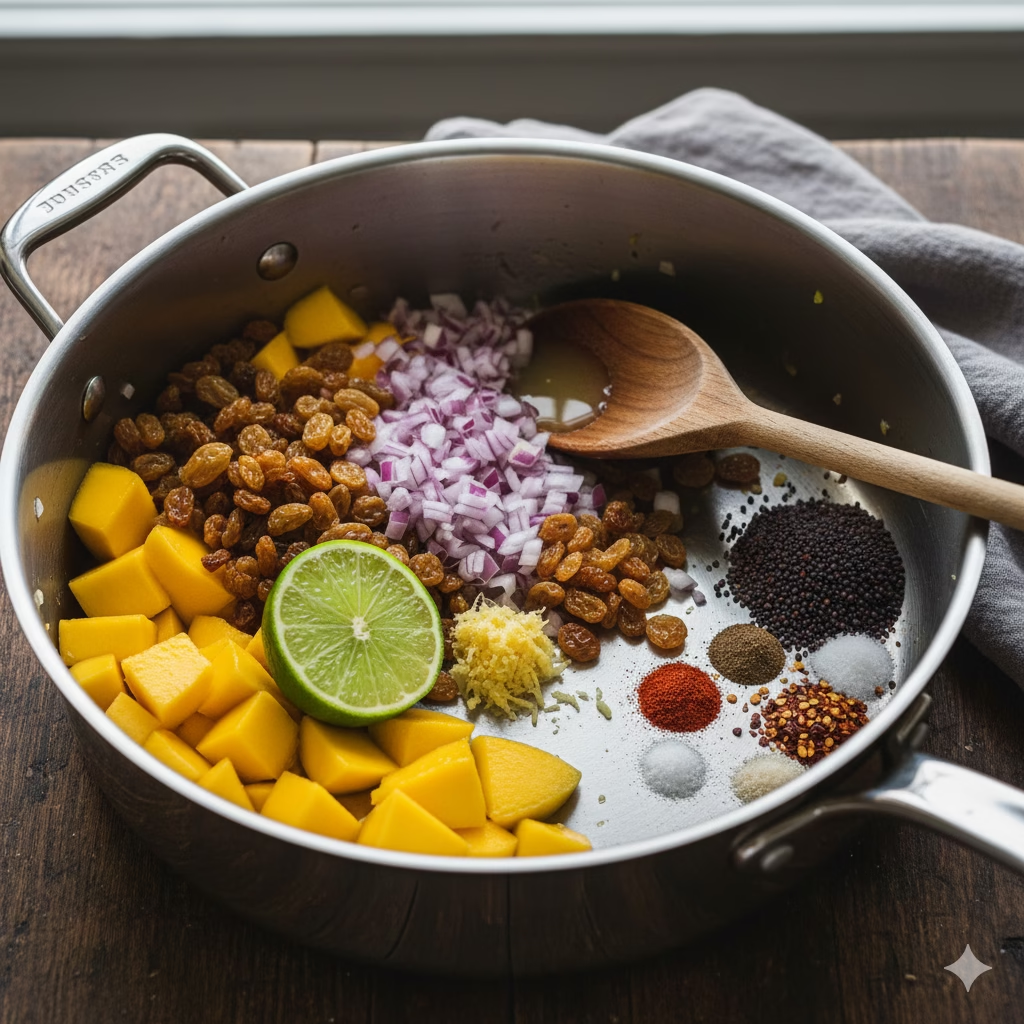
A classic, sweet, and tangy mango chutney with historical roots.
Ingredients:
- 3 ripe but firm mangoes, peeled and diced (about 3 cups)
- 1 cup apple cider vinegar
- ½ cup brown sugar
- ½ cup golden raisins
- ¼ cup finely chopped onion
- 2 tablespoons fresh lime juice
- 1 tablespoon fresh ginger, grated
- 1 teaspoon mustard seeds
- ½ teaspoon red pepper flakes (or more for heat)
- ¼ teaspoon ground cloves
- ¼ teaspoon ground allspice
- Pinch of salt
Instructions:
- Combine Ingredients: In a large, heavy-bottomed saucepan or Dutch oven, combine the diced mangoes, apple cider vinegar, brown sugar, golden raisins, chopped onion, lime juice, grated ginger, mustard seeds, red pepper flakes, ground cloves, ground allspice, and a pinch of salt.
- Bring to a Boil: Place the saucepan over medium-high heat and bring the mixture to a gentle boil, stirring occasionally to dissolve the sugar.
- Simmer and Reduce: Once boiling, reduce the heat to low and let the chutney simmer gently. Cook uncovered for 45-60 minutes, stirring frequently to prevent sticking, until the chutney thickens to a jam-like consistency and the mangoes are tender. The liquid should have significantly reduced.
- Cool and Store: Remove the chutney from the heat and let it cool completely. As it cools, it will thicken further. Once cool, transfer the chutney to sterilized jars.
- Serve: This chutney is excellent with cheese, roasted meats, or as a spread for sandwiches. Store in the refrigerator for up to 2-3 weeks, or process for longer storage.
5. Green Tomato Chutney Recipes
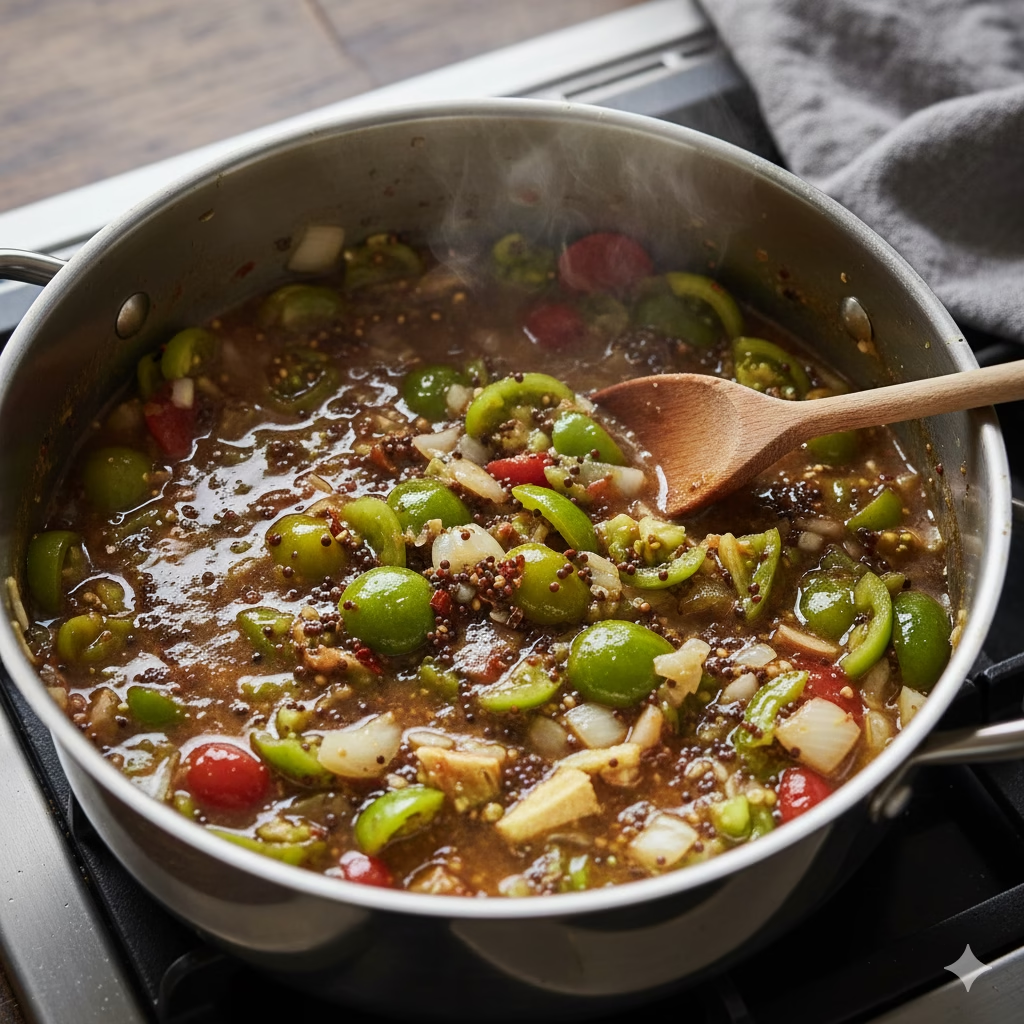
A tangy, sweet, and savory chutney made with unripe tomatoes.
Ingredients:
- 3 pounds unripe green tomatoes, cored and chopped
- 1 large onion, chopped
- 1 ½ cups apple cider vinegar
- 1 cup granulated sugar (or less for a tarter chutney)
- 1 tablespoon mustard seeds
- 1 teaspoon ground ginger
- ½ teaspoon red pepper flakes
- ½ teaspoon salt
Instructions:
- Prepare Tomatoes: Wash the green tomatoes thoroughly. Remove the cores and chop them into roughly ½-inch pieces. Chop the onion similarly.
- Combine and Simmer: In a large, non-reactive pot or Dutch oven, combine the chopped green tomatoes, chopped onion, apple cider vinegar, sugar, mustard seeds, ground ginger, red pepper flakes, and salt. Stir everything together.
- Cook Chutney: Bring the mixture to a boil over medium-high heat, stirring until the sugar dissolves. Once boiling, reduce the heat to low and let it simmer gently, uncovered, for about 1 to 1 ½ hours. Stir frequently, especially as it thickens, to prevent the bottom from scorching. The chutney is ready when it has thickened considerably, and most of the liquid has evaporated, resembling a relish.
- Cool and Jar: Remove the pot from the heat and let the chutney cool completely. As it cools, it will continue to thicken.
- Store: Transfer the cooled green tomato chutney into sterilized jars. Store in the refrigerator for up to 3-4 weeks. These chutney recipes are fantastic with grilled meats, burgers, or cheese.
6. Indian Spiced Vegetable Chutney
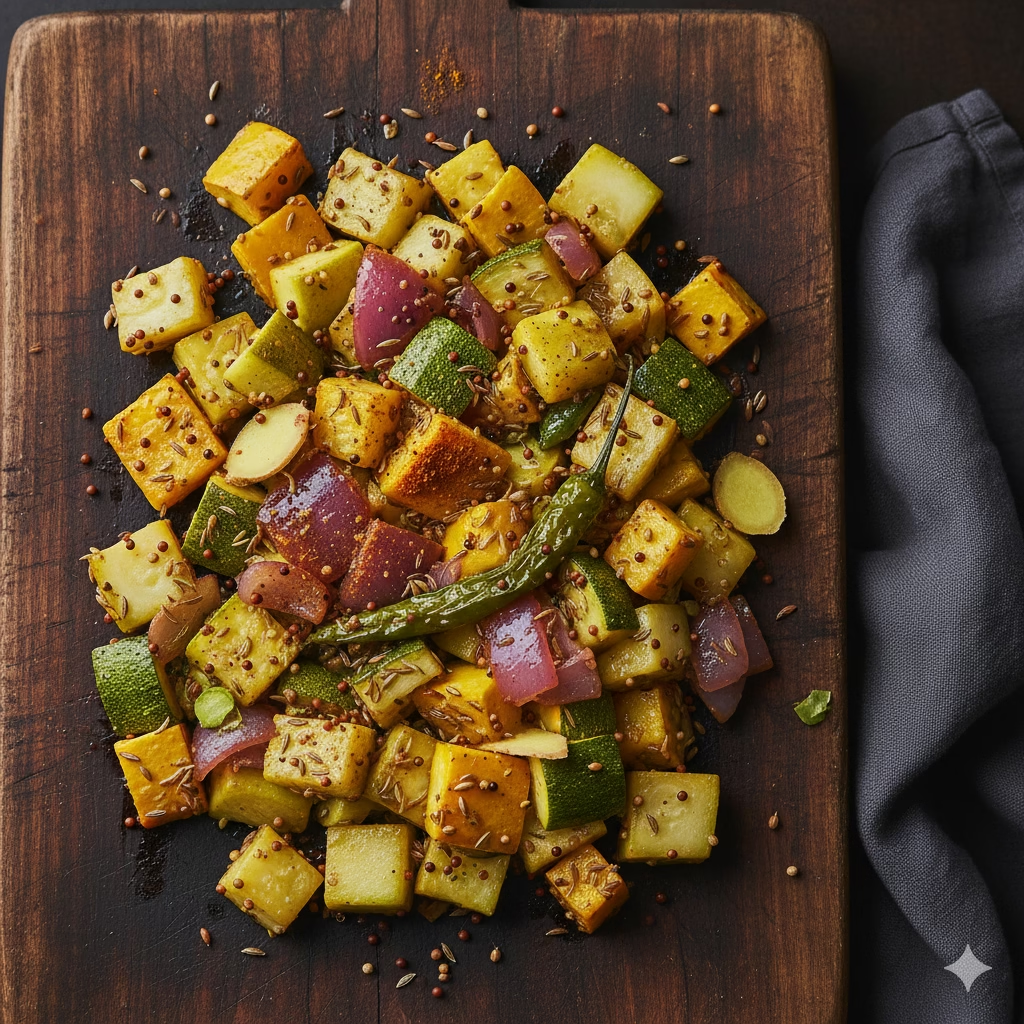
A chunky and aromatic chutney featuring mixed vegetables and warm Indian spices.
Ingredients:
- 1 cup chopped squash (e.g., butternut or zucchini)
- 1 cup chopped courgettes (zucchini)
- 1 large onion, chopped
- 1 tablespoon olive oil or coconut oil
- 2 cloves garlic, minced
- 1-inch piece ginger, grated
- 1 green chili, minced (optional)
- 1 teaspoon mustard seeds
- ½ teaspoon turmeric powder
- 1 teaspoon ground cumin
- 1 teaspoon ground coriander
- ¼ teaspoon asafoetida (hing)
- ½ cup apple cider vinegar
- ¼ cup brown sugar (or to taste)
- Salt to taste
Instructions:
- Sauté Aromatics: Heat the oil in a large saucepan or Dutch oven over medium heat. Add the mustard seeds and let them splutter. Then add the chopped onion and sauté until softened and translucent, about 5-7 minutes.
- Add Ginger, Garlic, Chili: Add the minced garlic, grated ginger, and minced green chili (if using). Sauté for another minute until fragrant.
- Incorporate Spices: Stir in the turmeric powder, ground cumin, ground coriander, and asafoetida. Cook for about 30 seconds, stirring constantly, to toast the spices.
- Add Vegetables and Liquids: Add the chopped squash and courgettes to the pot. Pour in the apple cider vinegar and brown sugar. Add salt to taste. Stir everything well to combine.
- Simmer to Perfection: Bring the mixture to a gentle boil, then reduce the heat to low. Cover the pot and simmer for 20-30 minutes, or until the vegetables are tender and the chutney has thickened. Stir occasionally to prevent sticking. If you prefer a thicker chutney, you can remove the lid for the last 10-15 minutes of cooking.
- Cool and Store: Remove from heat and let the chutney cool completely. Transfer to sterilized jars. These chutney recipes can be stored in the refrigerator for 1-2 weeks. Enjoy with curries, flatbreads, or as a side with roasted vegetables.
7. Mediterranean Vegetable Chutney

A vibrant and chunky condiment bursting with the flavors of the Mediterranean.
Ingredients:
- 2 cups ripe tomatoes, chopped
- 1 large red onion, chopped
- 1 red bell pepper, deseeded and chopped
- 1 green bell pepper, deseeded and chopped
- ½ cup red wine vinegar
- ¼ cup olive oil
- 2 cloves garlic, minced
- 1 tablespoon dried oregano
- 1 tablespoon fresh parsley, chopped
- 1 teaspoon sugar
- Salt and black pepper to taste
Instructions:
- Sauté Vegetables: Heat the olive oil in a large skillet or saucepan over medium heat. Add the chopped red onion, red bell pepper, and green bell pepper. Sauté for 8-10 minutes until the vegetables are softened.
- Add Aromatics and Herbs: Stir in the minced garlic and dried oregano. Cook for another minute until fragrant.
- Incorporate Tomatoes and Liquids: Add the chopped tomatoes, red wine vinegar, and sugar to the pan. Season with salt and black pepper to taste.
- Simmer and Thicken: Bring the mixture to a gentle boil, then reduce the heat to low. Let it simmer, uncovered, for 25-35 minutes, stirring occasionally, until the chutney has thickened and most of the liquid has evaporated. The vegetables should be tender but still hold their shape.
- Stir in Fresh Parsley: Remove the chutney from the heat and stir in the fresh chopped parsley.
- Cool and Store: Allow the chutney to cool completely before transferring it to sterilized jars. Store in the refrigerator for up to 1 week. These chutney Recipes are delicious with grilled fish, chicken, or as a topping for bruschetta.
8. Beetroot Chutney
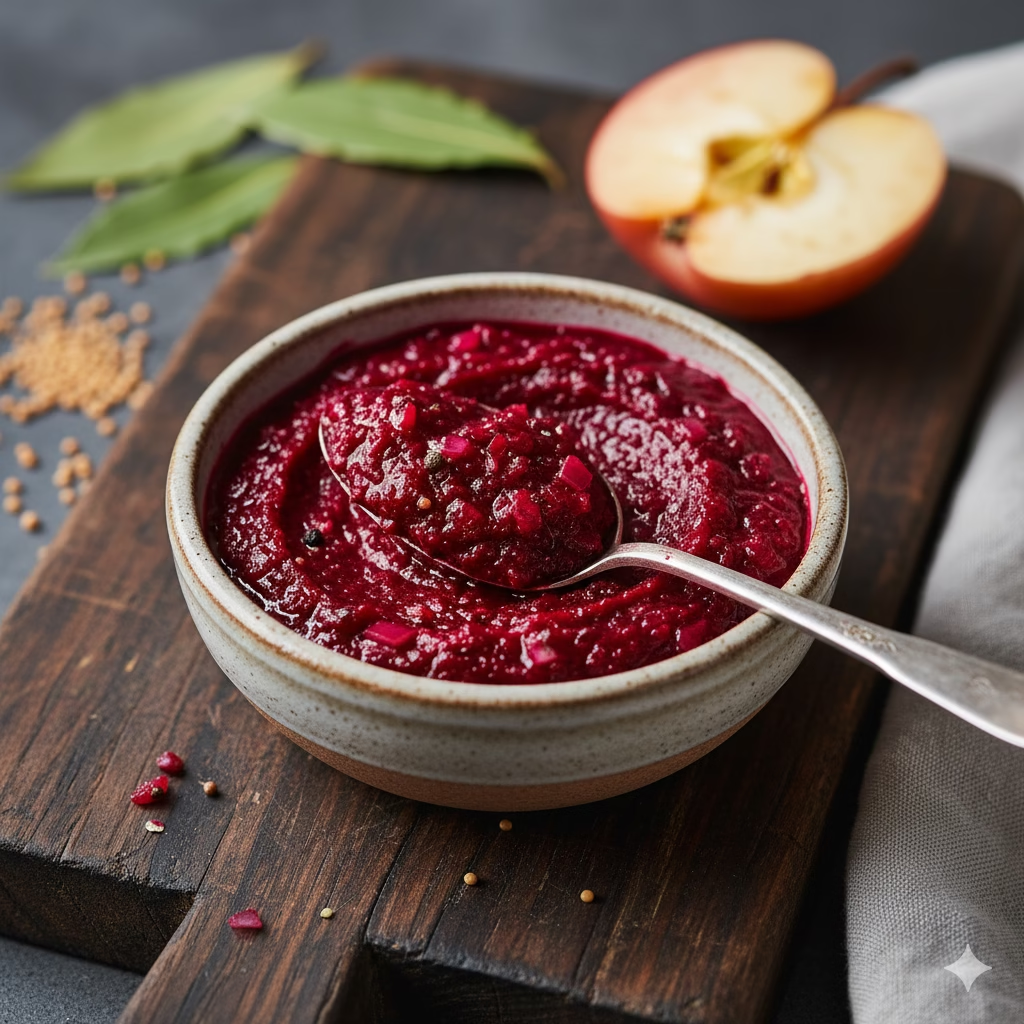
An earthy, sweet, and tangy chutney with a beautiful deep red color.
Ingredients:
- 2 medium beetroots, cooked, peeled, and grated (or finely chopped)
- 1 small onion, finely chopped
- 1 apple (e.g., Granny Smith), peeled, cored, and grated
- ½ cup apple cider vinegar
- ¼ cup brown sugar (or to taste)
- 1-inch piece ginger, grated
- ½ teaspoon mustard seeds
- ¼ teaspoon ground cloves (optional)
- Salt to taste
Instructions:
- Prepare Beetroot: Cook the beetroots until tender (you can boil, steam, or roast them). Once cooled, peel and grate them or chop them very finely.
- Sauté Aromatics: In a medium saucepan, combine the grated beetroot, chopped onion, grated apple, apple cider vinegar, brown sugar, grated ginger, mustard seeds, ground cloves (if using), and salt.
- Cook Chutney: Bring the mixture to a gentle boil over medium heat, stirring until the sugar dissolves. Reduce the heat to low and simmer, uncovered, for 20-30 minutes, stirring occasionally. The chutney is ready when it has thickened to your desired consistency.
- Cool and Store: Remove from heat and allow to cool completely. Transfer to sterilized jars and store in the refrigerator for up to 2 weeks. This chutney is excellent with cheese, cold meats, or burgers.
9. Avocado and Cilantro Chutney
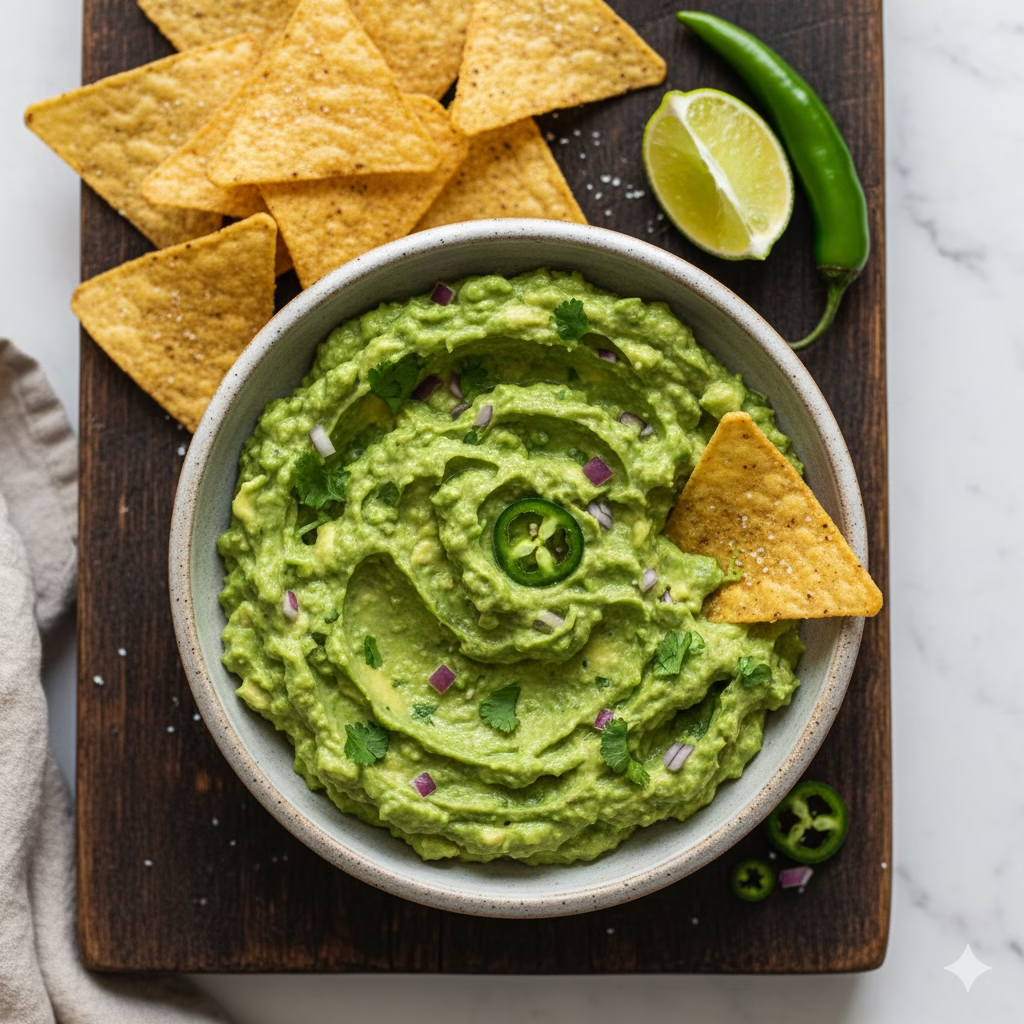
A quick, creamy, and zesty chutney, perfect as a dip or spread.
Ingredients:
- 1 ripe avocado, peeled and pitted
- ½ cup fresh cilantro leaves, packed
- 1 small green chili, deseeded if less heat preferred (or more to taste)
- 2 tablespoons lemon juice (or lime juice)
- 1 small clove garlic, minced (optional)
- Salt to taste
Instructions:
- Combine Ingredients: Scoop the flesh of the ripe avocado into a food processor or blender. Add the fresh cilantro leaves, green chili, lemon juice, and minced garlic (if using). Season with salt to taste.
- Blend until Smooth: Process the ingredients until a smooth and creamy chutney is formed. Scrape down the sides of the blender as needed. If it’s too thick, you can add a tiny splash of water (1 teaspoon at a time), but the avocado should provide enough creaminess.
- Taste and Adjust: Taste the chutney and adjust the seasoning. You might want to add more lemon juice for tang or a pinch more salt.
- Serve Immediately: This chutney is best served fresh to prevent browning. Enjoy it as a dip with tortilla chips, as a spread in sandwiches, or as a vibrant topping for tacos and grilled dishes.
10. Flaxseed Chutney
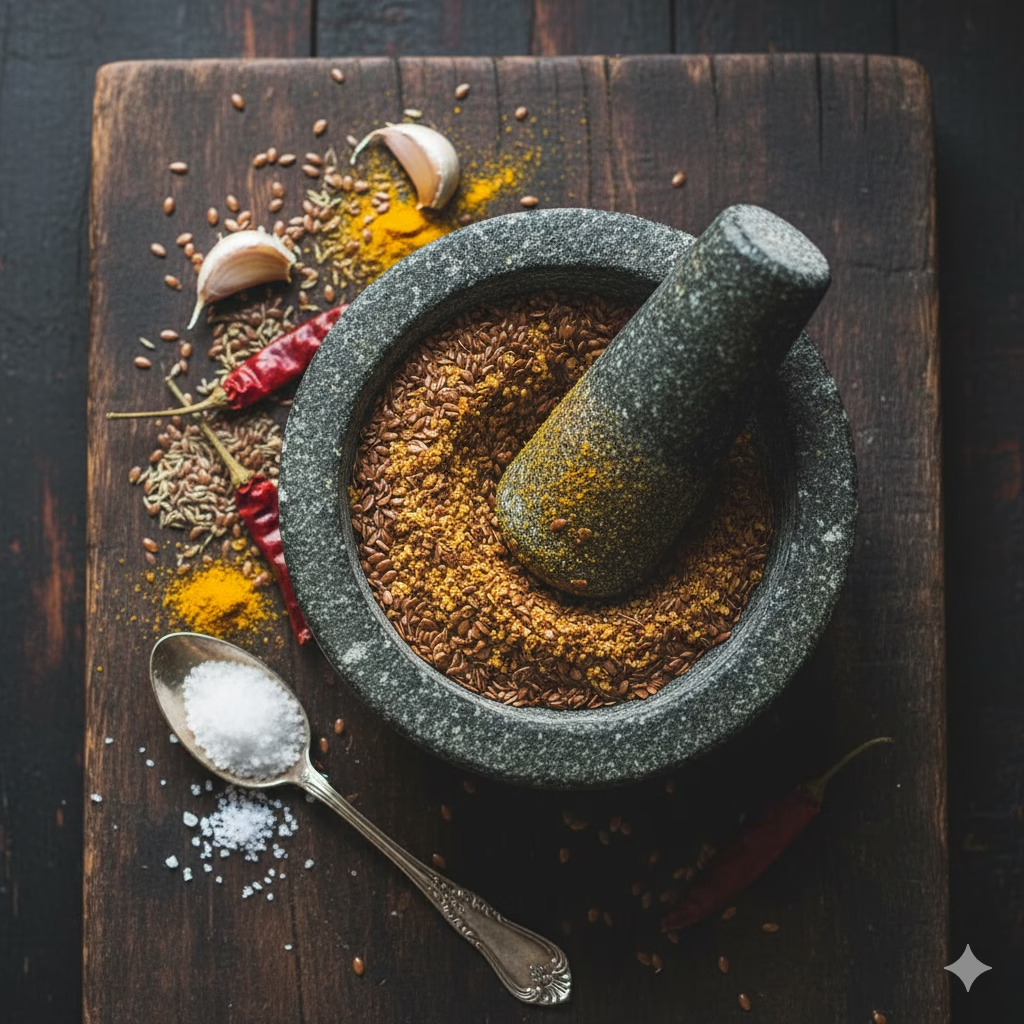
A healthy, nutty, and versatile dry chutney, packed with omega-3s.
Ingredients:
- ½ cup flaxseeds (linseeds)
- 2-3 dried red chilies (or to taste)
- 1 teaspoon cumin seeds
- ¼ teaspoon turmeric powder
- 2 cloves garlic (optional)
- Salt to taste
Instructions:
- Roast Flaxseeds: Heat a dry skillet or pan over medium-low heat. Add the flaxseeds and roast them, stirring constantly, for 3-5 minutes until they become fragrant and start to crackle slightly. Be careful not to burn them. Remove from the pan and let them cool completely.
- Roast Spices (Optional): In the same pan, lightly roast the dried red chilies and cumin seeds for about 30 seconds until fragrant. Remove from heat and let cool.
- Grind Ingredients: Once cooled, combine the roasted flaxseeds, roasted red chilies, roasted cumin seeds, turmeric powder, and garlic (if using) in a dry grinder or spice blender.
- Blend to a Coarse Powder: Grind the ingredients into a coarse, somewhat powdery mixture. Be careful not to over-grind, or the flaxseeds can release too much oil and become pasty. You want a textured powder.
- Season: Add salt to taste and pulse a few more times to combine.
- Serve or Store: This chutney can be served dry as a sprinkle over yogurt, rice, or salads. For a wet chutney, mix a tablespoon or two with a little water or oil just before serving. Store the dry chutney in an airtight container in a cool, dry place for several weeks.
11-23. More Exciting Chutney Recipes

These additional chutney recipes offer even more variety for your culinary adventures.
- 11. Onion Chutney: Caramelized onions with vinegar and spices.
- 12. Apple Chutney: Sweet and tart, great with pork or cheese.
- 13. Peach Chutney: Sweet and fruity, excellent with grilled chicken.
- 14. Rhubarb Chutney: Tart and refreshing, pairs well with lamb.
- 15. Date and Tamarind Chutney: Sweet, sour, and sticky, a classic for samosas.
- 16. Ginger Chutney: Pungent and spicy, a digestive aid.
- 17. Cranberry and Orange Chutney: Festive and vibrant, perfect for holidays.
- 18. Plum Chutney: Rich and sweet-tart, a great accompaniment to game meats.
- 19. Apricot Chutney: Sweet and tangy, good with curries.
- 20. Pineapple Chutney: Tropical and sweet, lovely with ham.
- 21. Tomato and Ginger Chutney: A savory and aromatic classic.
- 22. Sweet Potato Chutney: Creamy and subtly sweet, a unique twist.
- 23. Garlic and Coriander Chutney: Fresh, zesty, and highly aromatic.
The Health Benefits of Homemade Chutney Recipes

Making your own chutneys isn’t just about superior taste; it’s also about reaping significant health advantages. When you control the ingredients, you ensure a wholesome product free from unwanted additives.
Rich in Vitamins and Minerals
Many chutneys, particularly those made with fresh fruits and vegetables like mango, tomatoes, mint, and cilantro, are packed with essential vitamins and minerals. For instance, mint and cilantro chutneys are excellent sources of Vitamin K and antioxidants, while fruit-based chutneys offer a good dose of Vitamin C. These nutrients are vital for immune function, skin health, and overall well-being.
Boosts Digestion
Ingredients commonly found in chutneys such as ginger, garlic, cumin, and mustard seeds are known for their digestive properties. Ginger can alleviate nausea, garlic acts as a prebiotic, and spices like cumin can stimulate digestive enzymes. Fresh chutneys can add beneficial enzymes to your meal, aiding in the breakdown and absorption of nutrients.
Antioxidant Powerhouse
The vibrant colors in many chutneys are often indicative of their high antioxidant content. Berries, red chilies, and herbs like cilantro and mint are rich in compounds that fight free radicals in the body, reducing oxidative stress and potentially lowering the risk of chronic diseases.
Customizable for Dietary Needs
Homemade chutneys offer unparalleled flexibility. You can easily adjust sugar levels for those managing blood sugar, reduce sodium for heart health, or omit allergens. This control allows health-conscious individuals to enjoy flavorful condiments without compromising their dietary goals. By choosing fresh, organic ingredients, you maximize nutritional value and minimize exposure to pesticides and artificial substances.
Variations to Suit Every Palate
One of the greatest joys of making chutney at home is the ability to customize. Here are some ideas to tailor your chutney recipes:
| Variation Type | Description |
| Spice Level | Adjust the amount and type of chilies (green, red, dried, fresh). For milder chutneys, deseed chilies or use bell peppers. For extra heat, add a dash of cayenne pepper or a spicier chili variety like habanero. |
| Sweetness | Control the amount of sugar, honey, or jaggery. For a healthier option, use less refined sugar or natural sweeteners like dates or a touch of stevia. For tart chutneys, lean into less sugar. |
| Texture | Blend longer for a super smooth paste or pulse briefly for a chunky, relish-like consistency. For cooked chutneys, adjust cooking time; longer cooking yields a more jam-like texture. |
| Flavor Profile | Experiment with different vinegars (apple cider, white wine, balsamic) for varied tanginess. Add fresh herbs (dill, basil, chives) for an aromatic twist. Incorporate nuts or seeds (peanuts, cashews, sesame seeds) for added crunch and richness. Introduce smoked paprika or liquid smoke for a smoky flavor. |
| Dietary Needs | Vegan: Most chutneys are naturally vegan. Gluten-Free: Ensure all spices and additives are certified gluten-free. Low-Sodium: Omit added salt or use a low-sodium salt alternative. Low-Sugar: Substitute sugar with natural fruit sweetness, or use very small amounts of alternative sweeteners. |
| Fruit/Veggie Swaps | Don’t have mango? Try peaches or apricots. No green tomatoes? Use firm red tomatoes or tomatillos. Be creative with seasonal produce; almost any fruit or firm vegetable can be transformed into a delicious chutney with the right balance of sweet, sour, and spice. Consider combinations like apple-pear, or mixed berry. |
| Aromatic Enhancements | Fry whole spices like fenugreek seeds, nigella seeds, or star anise in a little oil before adding other ingredients for a deeper flavor. A pinch of asafoetida (hing) can add a savory, umami note. |
Final Thoughts on Your chutney Recipes

Embarking on the journey of making your own chutneys is a rewarding experience that extends far beyond just culinary enjoyment. It’s about reconnecting with whole ingredients, understanding the alchemy of flavors, and creating wholesome, vibrant condiments that nourish both body and soul. Each jar of homemade chutney is a testament to your creativity and care, transforming simple meals into extraordinary dining experiences.
We hope these 23 chutney recipes inspire you to explore the endless possibilities of this versatile condiment. Don’t be afraid to experiment, adjust, and make each recipe your own. Your kitchen is your laboratory, and every batch of chutney is an opportunity to discover new favorite flavors. Share your creations, experiment with pairings, and most importantly, savor the delicious rewards of your efforts. Happy chutney making!
Frequently Asked Questions (FAQs)
Q1: How long do homemade chutneys last?
A1: The shelf life of homemade chutneys varies depending on the ingredients and whether they are cooked or fresh. Cooked chutneys (like Major Grey’s or Green Tomato Chutney), properly sealed in sterilized jars and refrigerated, can last for 2-4 weeks. If processed via canning, they can last for several months to a year. Fresh, uncooked chutneys (like Cilantro Mint or Avocado Chutney) should be consumed within 3-5 days when stored in an airtight container in the refrigerator, as they are more perishable.
Q2: Can I freeze chutney?
A2: Yes, many cooked chutneys can be frozen to extend their shelf life significantly. Allow the chutney to cool completely before transferring it to freezer-safe containers or bags. Leave a little headspace for expansion if using rigid containers. Frozen chutney can last for 3-6 months. Thaw in the refrigerator overnight before serving. Fresh, uncooked chutneys, particularly those with delicate herbs or avocado, might not freeze as well in terms of texture and freshness, so it’s generally best to enjoy them fresh.
References
- Healthyfood – Are chutneys and pickles good for you?
- WebMD – Health Benefits of Cilantro
- USDA – Flaxseed, ground
Recent Posts
